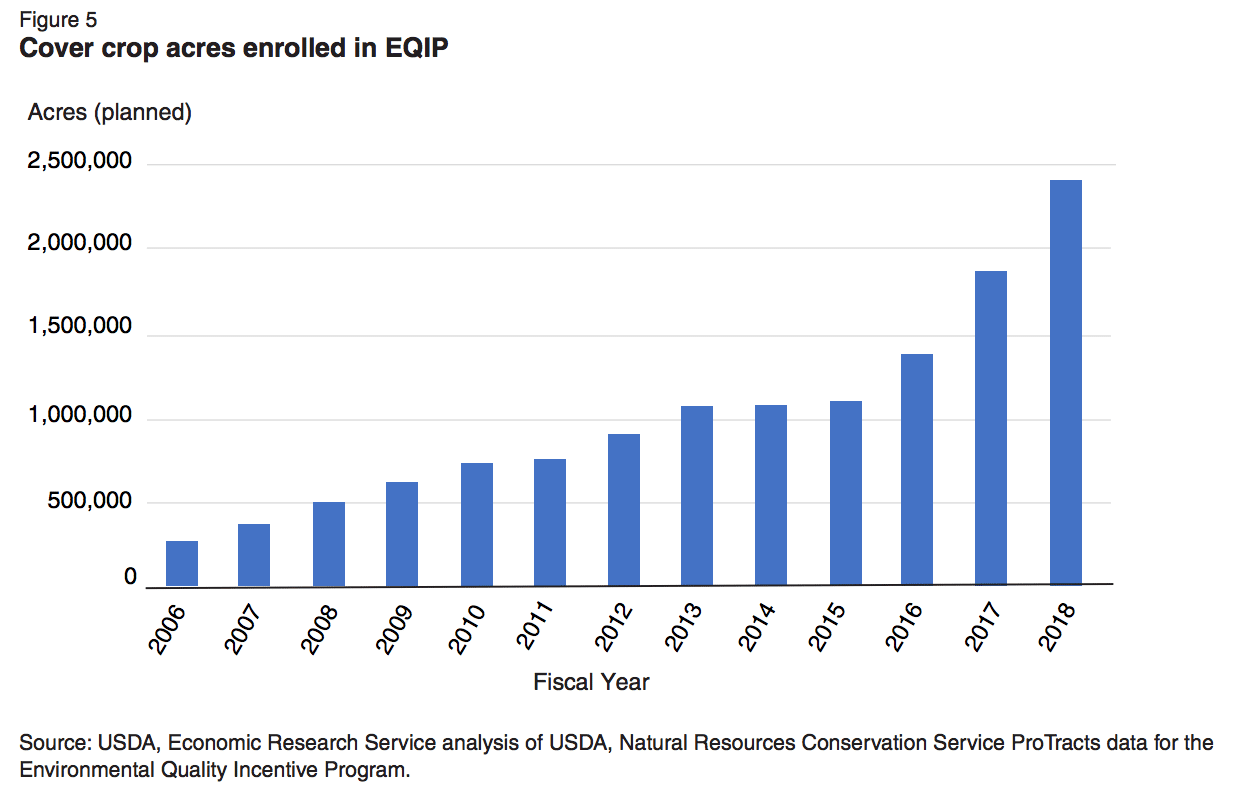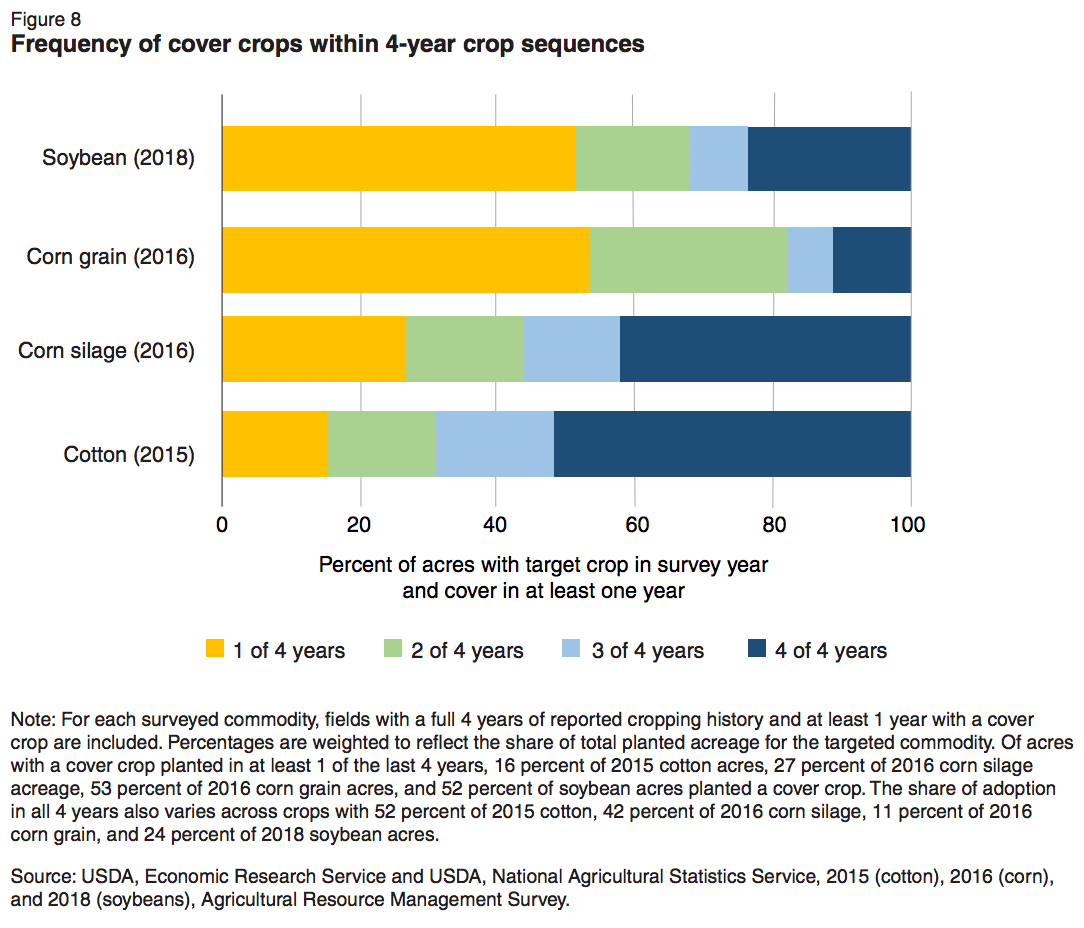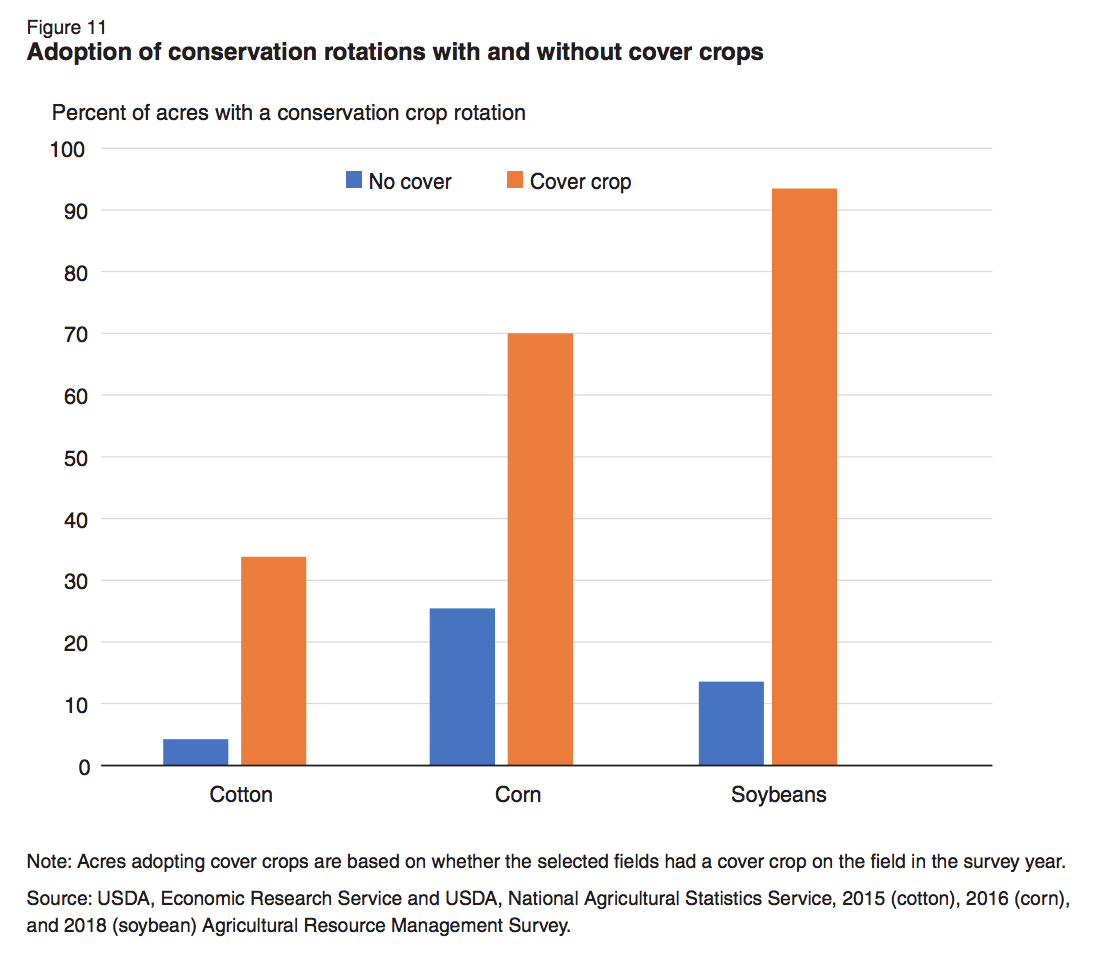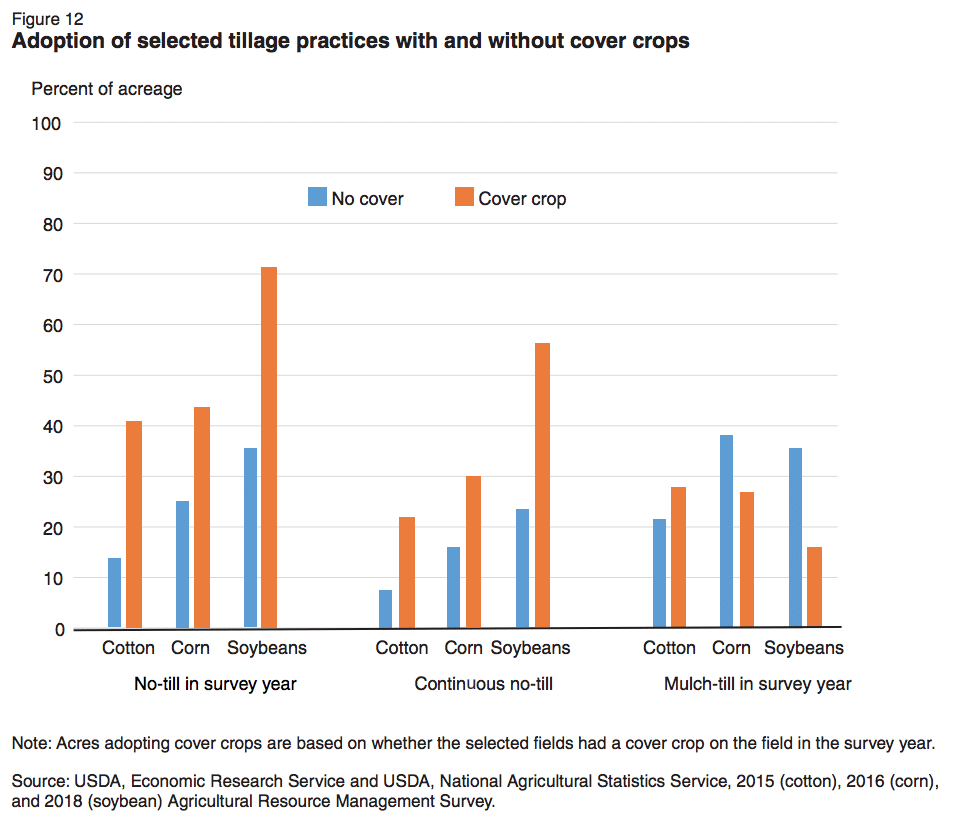Regenerative Practices 101 Pathway:
USDA: Cover Crop Trends, Programs,
and Practices in the United States
According to the USDA, between 2012 and 2017, the use of cover crops in the United States increased by 50 percent. When farmers implement cover crops into crop rotation, there are many benefits for not only the farmers but society as well. That is why the federal and state conservation programs increased efforts to promote cover crops through financial assistance. The benefits of cover crops are dependent upon the type of cover crop used, the method used to terminate its growth, soil health management, and more.

The USDA conducted a report on how cover crops are managed on corn, cotton, soybean, and wheat fields. The survey revealed that there are many different management practices and approaches to using cover crops. There are varying soil-health-related practices farmers use with cover cropping, such as conservation cropping, no-till farming, and soil testing.
In 2014, USDA agencies revised their definition of a cover crop for consistency across agencies, as follows: “Crops, including grasses, legumes, and forbs, for seasonal cover and other conservation purposes. Cover crops are primarily used for erosion control, soil health improvement, and water quality improvement. A cover crop managed and terminated according to these guidelines is not considered a ‘crop’ for crop insurance purposes. The cover crop may be terminated by natural causes such as frost, or intentionally terminated through chemical application, crimping, rolling, tillage, or cutting”. Further, USDA’s definition allows for grazing and harvesting under specific conditions, as follows: “Cover crops may be grazed or harvested as hay or silage, unless prohibited by RMA (Risk Management Agency) crop insurance policy provisions. Cover crops cannot be harvested for grain or seed.”
There are many onfarm benefits that can result from cover crops. These benefits include reduced soil erosion and compaction, improved water infiltration and storage within the soil profile, greater weed and pest suppression, and better nutrient cycling and soil stability to support machine operations. Cover crops can also provide public environmental benefits such as greater soil carbon sequestration, less runoff of sediments and nutrients into waterways, and reduced flooding in watersheds.
Cover crops that are well-managed provide a living, seasonal coverage of soil between forage or cash crops. For the land itself, cover crops can provide many benefits. They can decrease soil erosion, improve water infiltration and storage within the soil profile, provide pest suppression, and better nutrient cycling and soil stability to support machine operations. They can also provide environmental benefits such as less sediment runoff and reduced flooding in watersheds, nutrients into waterways, and greater soil carbon sequestration. The USDA and many states have become more aware of the benefits of cover crops. Therefore, they have increased financial assistance through working lands conservation programs.

Cover crops can help conserve soil, keep nutrients in place for the next cash crop, and promote improved soil health. However, these benefits can be even greater when combined with other practices. The exact combination of practices that is optimal on a farm will depend on the ecosystem, climate, soil, and other factors. According to this article, farmers who planted cover crops before planting corn, soybeans, and cotton are more likely to use other conservation practices along with cover crops.
Conservation crop rotation is growing a sequence of various crops that is planned on the same section of land for a variety of conservation purposes including soil health, soil erosion control, and more. Conservation rotations can help promote crop diversity and ensure soil cover. The USDA uses a definition of a conservation rotation based on four criteria: (1) an average residue rating greater than 1.5; (2) inclusion of more than one crop; (3) including a crop with low-nitrogen-demand; (4) and at least 1 crop with residue rating greater than or equal to 2. The average residue rating is the sum of residue ratings for individual crops in the conservation rotation divided by the number of years in the rotation. For each crop in the crop history, they assign an annual residue rating obtained from Natural Resources Conservation Service (NRCS). For each crop, residue ratings range from 0.25 to 4.0. Very high-residue continual crops (e.g., alfalfa and grasses) have a residue rating of 4. High-residue annual crops (e.g., corn, wheat, sorghum, and barley) have a residue rating of 2. Low-residue annual crops (e.g., soybeans and cotton) have a residue rating of 1.
Cropping systems that include cover crops are, in fact, more likely to be in conservation rotations because cover crops help satisfy crop diversity and residue requirements (figure 11 below). For example, a simple corn and soybean rotation would not meet the definition of a conservation rotation, but a corn and soybean rotation with winter cover crops would meet the definition. The association between cover crops and the use of conservation rotations in corn and cotton is more limited than for soybeans because corn and cotton fields do not always include a legume or other crops with low-nitrogen fertilizer demands.

No-till can help decrease physical soil disturbance, particularly when farmers use no-till continuously over time. Farmers who reported using a cover crop in the fall before planting were also more likely to use no-till in corn, soybeans, and cotton (as seen in figure 12 below). No-till in the survey year and on all crops in the crop history (a total of 4 years) is less frequent. For example, in 2016, 27% of corn was in no-till, but less than 20% of the surveyed fields had been in no-till continuously for more than 4 years. No-till is often in rotation with other tillage practices and is often based on the crop grown in any given year (e.g., no-till is more likely in soybeans than in corn).

When applying soil health principles, nutrient management is important as well. This is a reason that the USDA’s working lands programs sometimes provide financial assistance for soil testing. There may be some needed adjustments to nutrient management strategies to account for changes in the availability of nitrogen from higher levels of crop residue, increased use of legumes (as cover crops or part of conservation rotations), reduced tillage, and the amount of nitrogen mineralized from soil organic matter. Nitrogen may also be stuck in the residue of small grain cover crops during the beginning of the season, a situation that could require an increase in fertilizer early in the growing season for some crops.
In the United States, in 2017, farmers planted an estimated 15.4 million acres of cover crops. There has been a very recent and rapid growth in cover crop acreage: a 50% increase between 2012 and 2017. Some of this growth is due to State and Federal conservation programs that pay farmers to plant cover crops. More than 3 million acres in 2015 received a cover crop payment from either CSP or EQIP. In EQIP alone, funding for cover crops has increased by nearly $150 million between 2005 and 2018. In addition to the Federal programs, at least 22 States also now have cover crop programs of their own.
Managing soil health and conservation requires more than just the implementation of cover crops. Conservation crop rotations, conservation tillage, and nutrient management are among the practices that can make up a soil-health-focused management system. In soybean, corn, and cotton fields that use cover crops, no-till is more common than it is on fields without cover crops. Also, the use of compost or animal manure is more common on cornfields with cover crops than those without. Lastly, cover crop fields are more likely to be testing for soil organic matter and nutrients as well.
As cover crops become more of a common practice, we will be able to find out more information about cover crop trends and management in U.S. field crops. It will be particularly interesting to see the impact of government programs and incentives on farmers’ adoption of cover crops. As well as the impact of cover crops on production practices (like nutrient management) and the impact of cover crops on soil health and yields. This report provides a lot of valuable insights and CIBO encourages you to check out the full article to be able to fully understand the USDA cover crop trends.
Return to the pathway to build your knowledge of regenerative agriculture
Return to Pathway